Stanford HistoryPrologue
From this campsite, on which one corner of the Stanford campus is now situated, Portola's reconnoitering parties explored the area for almost a week. Later, from this same campsite, Francisco de Ortega explored the eastern shore of the Bay. The old redwood, then twin-trunked and well over 100 feet high, was a landmark visible for miles. In 1876, Governor Leland Stanford purchased 650 acres of El Rancho San Franciscquito for a country home and began the development of his famous Palo Alto Stock Farm for trotting horses. The farm later became the Stanford campus, and the little town that started to grow up across El Camino Real from the University also took the name Palo Alto. Today El Palo Alto is rooted precariously on the east bank of San Francisquito Creek, close to the Southern Pacific Railroad tracks. Many years ago one of the winter floods that periodically rushed down the arroyo tore off one of its twin trunks, but half of the venerable old tree lives on, a gaunt and time-scarred monument. From Stanford's beginning, the Palo Alto has been the University's symbol and the centerpiece of its official seal. Birth of the University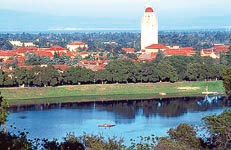 On October 1, 1891, Stanford University opened its doors after six years of planning and building. In the early morning hours, construction workers were still preparing the Inner Quadrangle for the opening ceremonies. The great arch at the western end had been backed with panels of red and white cloth to form an alcove where the dignitaries would sit. Behind the stage was a life-size portrait of Leland Stanford, Junior, in whose memory the University was founded. About 2,000 chairs, many of them sturdy frontier Douglas chairs used in classrooms, were set up in the three-acre Quad, and they were soon filled to overflowing. By midmorning, people were streaming across the brown fields on foot. Riding horses, carriages and farm wagons were hitched to every fence and at half past ten the special train from San Francisco came puffing almost to the University buildings on the temporary spur that had been used during construction. Just before 11:00 am, Leland and Jane Stanford mounted to the stage. As Mr. Stanford unfolded his manuscript and laid it on the large Bible that was open on the stand, Mrs. Stanford linked her left arm in his right and held her parasol to shelter him from the rays of the noonday sun. He began in measured phrases: "In the few remarks I am about to make, I speak for Mrs. Stanford, as well as myself, for she has been my active and sympathic coadjutor and is co-grantor with me..." What manner of people were this man and this woman who had the intelligence, the means, the faith and the daring to plan a major university in Pacific soil, far from the nations's center of culture - a university that broke from the classical tradition of higher learning? Leland Stanford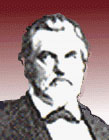 A story of Stanford, the University, could not be complete without a history of Stanford, the man. The fifth of eight children, Leland Stanford was born at the family home on a farm near Albany, New York. Hard work and schooling filled his early years and in 1848, after three years in an Albany law firm, he was admitted to practice. In search of greater opportunity, he went to Port Washington, Wisconsin, on Lake Michigan, to hang out his shingle. Two years later he married Jane Eliza Lathrop, daughter of a well-to-do Albany merchant. His practice in Port Washington was successful but in 1852, after a fire wiped out his office and $3,000 library, his pioneer spirit sprung into high gear and he joined his five brothers in their mercantile business in the gold fields of California. Leaving his wife in Albany, he went to California by way of the Isthmus. He spent two years in the Stanford Brothers' store in Michigan Bluff, 30 miles northeast of Auburn. Life was hard. Stanford slept on the counter under buffalo robes with his boots for a pillow except when flood waters forced him to hoist sugar barrels and other heavy articles to the counter for safekeeping. Nevertheless, Stanford prospered. In three years he bought out the Stanford Brothers' store in Sacramento and he returned to Albany for his wife. 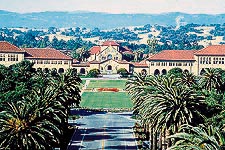 Stanford became the most active member of a small group organizing the Republican Party in California and was the party candidate for state treasurer in 1857, and for governor in 1859. There had been no chance for election, but the party was gaining a foothold. In 1860, he stumped the state for Abraham Lincoln and the Lincoln electors won. Soon thereafter, Stanford visited Lincoln in Washington, and although many Eastern Republicans underestimated the President, Stanford was deeply impressed. In 1861, he told the California Republican convention that the South stood for aristocracy while the Union represented democracy. He was nominated for governor and won decisively after stumping from one end of the state to the other, with Jane at his side. Stanford succeeded not only in holding California in the Union, but also saw to it that the state contributed substantially to Union victory. But of even greater importance in keeping America united as a republic was Stanford's part in building the first transcontinental railroad. San Francisco businessmen, well satisfied with the profits they were making from sea routes, turned their backs on the hazardous undertaking. The steep, snow-covered slopes of the Sierra Nevada could just as easily turn the builders into bankrupt paupers as princes of industry. But a group of Sacramento merchants took the high stakes gamble and they formed the Central Pacific Railroad company to lay track eastward to connnect with the westward-building Union Pacific. 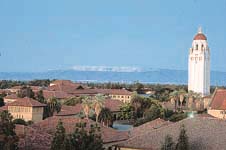 Stanford, who had demonstrated business acumen and qualites of leadership, was elected president of the venture. Congress voted generous land grants and bonded loans, but the main sums had to be supplied by the companies. Stanford, Collis P. Huntington, Mark Hopkins and Charles Crocker emerged as the "Big Four" who risked their financial hides and worked nearly to the breaking point as they pushed their crews to meet the Union Pacific at a point as far east as possible. On May 10, 1869, trains of the two roads drew together at Promontory, Utah. Leland Stanford wielded a sledge of Nevada silver to tap a spike of California gold into a polished laurel tie. The blows activated a telegraph key which clattered across the nation: "Done!" |
On Campus
Share
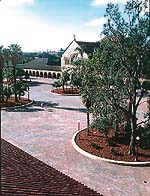 In November 1769, Captain Gaspar de Portola's expedition to find and fortify the port of Monterey for Spain, found instead San Franciso Bay. The party camped near the giant California Coast Redwood which later travelers along the San Francisco Peninsula came to call El Palo Alto, "the high tree," as the native Ohlone Indians had probably called it for centuries before.
In November 1769, Captain Gaspar de Portola's expedition to find and fortify the port of Monterey for Spain, found instead San Franciso Bay. The party camped near the giant California Coast Redwood which later travelers along the San Francisco Peninsula came to call El Palo Alto, "the high tree," as the native Ohlone Indians had probably called it for centuries before.